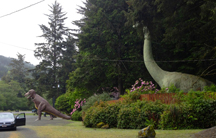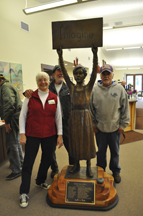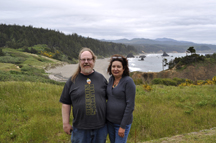Kris Anderson is the co-author of State of Giving: Stories of Oregon Volunteers, Donors, and Nonprofits, along with the former president of the Oregon Community Foundation, Greg Chaillé. In anticipation of the book's imminent publication in April 2015, we asked Kris to share some of her experiences writing the book, as well as her take on what makes Oregon such an inspiring place.
Researching State of Giving meant a lot of time on the road. So we can tell you this with authority: Oregon’s scenic byways host some iconic roadside attractions. Petersen’s Rock Gardens, Harvey the Rabbit, and the world’s largest pig hairball, to name a few.  But the Prehistoric Gardens on Highway 101 is one of the more arresting. Cruising along the southern coast’s wave-beaten monoliths and forested headlands, a bend in the road brings you face-to-face with a life-size T-Rex reaching with feeble arms and a cartoonish expression towards your car.
But the Prehistoric Gardens on Highway 101 is one of the more arresting. Cruising along the southern coast’s wave-beaten monoliths and forested headlands, a bend in the road brings you face-to-face with a life-size T-Rex reaching with feeble arms and a cartoonish expression towards your car.
It’s a surreal moment, and a charming one. Like many of its roadside kin, Prehistoric Gardens seems a relic of a more credulous, less globalized era of travel. Its hand-painted sign has a typo; its concrete monsters have the lumbering, mud-tailed postures of long outdated paleontological theories. It’s less Jurassic Park, more Flintstones. And it’s a worthwhile stop, especially for fans of nostalgia and kitsch.
A few miles away is Port Orford, a small town that, like many small rural towns in Oregon, could easily be viewed by a stranger through similar lenses: as a quaint, appealing relic of something bygone—and as a nice tourist stopover. It has galleries on the main street, the ubiquitous myrtlewood shops, a beautiful adjacent bay and state park, a few derelict storefronts, and a message sprayed on the asphalt of a side road that reads “Ocean View This Way.”
That’s what you see when you cruise through at 35 miles an hour, at least, or poke around for the afternoon. But, as with many of Oregon’s rural communities, Port Orford deserves to be regarded as more than a roadside attraction for out-of-towners.
One of our key arguments in State of Giving is that across Oregon, there’s fascinating, inventive, and very contemporary work going on to enliven and sustain our state’s communities and landscapes. Much of it is entirely grassroots, created and championed by volunteers, local donors, and impassioned nonprofit and civic leaders. And some of the most engaged, progressive visions are coming out of tiny places like Port Orford: far from being sepia-toned backwaters, Oregon’s small towns are hotbeds of citizen activism and creativity.
State of Giving isn’t just about small town altruism and activism—its perspective is statewide, and it chronicles volunteerism, philanthropy, and civic leadership across many sectors and  demographics. It is organized by sector, with each chapter detailing wide-ranging efforts to counteract what we regard as the key challenges facing Oregon: the urban/rural divide, education inequity, environmental degradation, poverty (and the hunger and homelessness it precipitates), dwindling support for Oregon’s cultural and heritage industries, and systemic social inequity and injustice. We profile organizations ranging from Basic Rights Oregon to the Jefferson County Historical Society to Albina Head Start to Wallowa Resources, a consensus-building environmental nonprofit headquartered in Enterprise. But while we outline why each organization is doing vital work, our profiles focus less upon the institutions themselves and more upon the volunteers, donors, and staff that are driving their work forward—first and foremost, this is a book about people.
demographics. It is organized by sector, with each chapter detailing wide-ranging efforts to counteract what we regard as the key challenges facing Oregon: the urban/rural divide, education inequity, environmental degradation, poverty (and the hunger and homelessness it precipitates), dwindling support for Oregon’s cultural and heritage industries, and systemic social inequity and injustice. We profile organizations ranging from Basic Rights Oregon to the Jefferson County Historical Society to Albina Head Start to Wallowa Resources, a consensus-building environmental nonprofit headquartered in Enterprise. But while we outline why each organization is doing vital work, our profiles focus less upon the institutions themselves and more upon the volunteers, donors, and staff that are driving their work forward—first and foremost, this is a book about people.
Petite Port Orford, weighing in at a mere 1133 residents as of the 2010 Census, provides a number of outsized examples. Port Orford isn’t always an easy place to live: its once-vibrant forest products industry is now virtually extinct, its fishing industry has faced similar threats, it has an aging population, 54% of its residents are low-to-middle income, and it’s part of Curry County, which has one of the lowest tax rates in Oregon, meaning that investments in roads, schools, and basic services have all declined sharply. But the town also has a lot going for it: a stunning location, a temperate climate, a fertile ocean, a robust arts scene, a growing tourist economy, and most of all, a very close-knit, hands-on, git-‘er-done community.
Local artist and mom Allandra Emerson, for example, hated that the local schools had to cut arts education from their dwindling budgets but realized that the town had an untapped resource. “We have a healthy arts community here, but there’s not much overlap between the artists and parents of school-age children.” With her encouragement, the Port Orford Arts Council set up a Saturday arts program for children that eventually became incorporated—powered by volunteer labor from the arts community—back into the school day. “That way you can reach the maximum number of kids, not just kids whose parents are interested in the arts,” Allandra explains.
The Arts Council also runs a program at Port Orford’s library, itself the product of impressive civic leadership. For over seventy years, the Port Orford Library was just a room in a crumbling municipal building. But in 1995, residents of Port Orford formed the Library Foundation, a nonprofit established to find the library a permanent home. Led by the irrepressible Tobe Porter, the town raised over $1.8 million dollars and 70% of the community voted in favor a $450,000 bond to be used if needed. In 2008, on the day Port Orford Public Library opened it doors, “four hundred or so people lined up outside. They would just stop and look at it and cry with pride. It’s a library that the community built 100 percent,” Tobe recalls. Under Tobe’s leadership, the library now is a de facto community center, offering everything from job search training to yoga classes to town hall discussions.
The library has also hosted conversations that led to one of Port Orford’s most  visible successes: the transformation of its fishing industry. Helmed by fisherman’s wife Leesa Cobb and supported by board chair Aaron Longton, a commercial salmon and black cod fisherman, Port Orford Ocean Resource Team [POORT] “arose out of necessity,” Aaron says. “Our town had lost its timber jobs, and the fishing was hit-or-miss… Everyone knew there’d be change, and that to weather the storms, we’d have to adapt [and] to organize ourselves.” With Leesa’s vision and with widespread support, including thousands of volunteer hours from local fishermen, Port Orford has taken a leadership role in marine conservation by creating a sustainable fishing industry and a locally administered maritime preserve. POORT has won regional and national conservation awards, attracted support from big-name funders, sells its sustainably-harvested fish statewide, and most of all, has helped place this little town on the cutting edge of triple-bottom-line solutions.
visible successes: the transformation of its fishing industry. Helmed by fisherman’s wife Leesa Cobb and supported by board chair Aaron Longton, a commercial salmon and black cod fisherman, Port Orford Ocean Resource Team [POORT] “arose out of necessity,” Aaron says. “Our town had lost its timber jobs, and the fishing was hit-or-miss… Everyone knew there’d be change, and that to weather the storms, we’d have to adapt [and] to organize ourselves.” With Leesa’s vision and with widespread support, including thousands of volunteer hours from local fishermen, Port Orford has taken a leadership role in marine conservation by creating a sustainable fishing industry and a locally administered maritime preserve. POORT has won regional and national conservation awards, attracted support from big-name funders, sells its sustainably-harvested fish statewide, and most of all, has helped place this little town on the cutting edge of triple-bottom-line solutions.
Allandra, Tobe, Leesa, Aaron, and many more like them have ensured that there’s more to Port Orford than meets the roadtripper’s eye. While it has tourist attractions and bygone industries, it’s no quaint throwback—it’s no concrete dinosaur. Rather, Port Orford is just one of hundreds of Oregon communities benefitting from the altruism and activism of folks who give time and money to help transform economies, conserve valuable ecologies, and improve lives.
If you want to hear more from Leesa and Tobe, if you want to learn more about the seminal challenges facing our state, if you want to read about vanguard citizens and organizations working to combat these challenges, if you run a nonprofit or are a volunteer or donor, or if you just want to glean some ideas about how you can engage more deeply with your community, State of Giving might be right up your alley. We had a blast writing it—world’s largest pig hairball notwithstanding—and hope it makes for an entertaining, illuminating, and mobilizing read.
—Kris Anderson
Photographs courtesy of Kris Anderson
Related Titles

State of Giving
State of Giving is at once an authoritative overview of Oregon’s toughest challenges and a much-needed manifesto for greater civic engagement. Chaillé and Anderson highlight...
